new posts in all blogs
Viewing: Blog Posts Tagged with: repetition, Most Recent at Top [Help]
Results 1 - 12 of 12
How to use this Page
You are viewing the most recent posts tagged with the words: repetition in the JacketFlap blog reader. What is a tag? Think of a tag as a keyword or category label. Tags can both help you find posts on JacketFlap.com as well as provide an easy way for you to "remember" and classify posts for later recall. Try adding a tag yourself by clicking "Add a tag" below a post's header. Scroll down through the list of Recent Posts in the left column and click on a post title that sounds interesting. You can view all posts from a specific blog by clicking the Blog name in the right column, or you can click a 'More Posts from this Blog' link in any individual post.
In
Esther’s last post, she pointed out a series of “re-” words related to
Kate Messner’s
Real Revision. I’ll add another: Repetition. Along with rhythm and rhyme, it’s one of the three important patterns in poetry that I discuss in
Write a Poem Step by Step. (By the way, we’re giving away an autographed copy! See below to enter for your chance to win!)
Here’s an excerpt from the book:
What do you do when you want to remember something? Do you say it to yourself again and again until you learn it? That’s using repetition. Repetition is an effective technique in poetry. It helps create a pattern in a poem. It can help us remember. It can add emphasis to a certain word or phrase. It can connect the parts of a poem to each other.
(Rahel Spilka wrote the following poem in one of my workshops many years ago. It's still one of my favorites.) Repetition ties Rahel’s poem together.
Blowing in the Wind
The tree’s branches are
blowing in the wind.
Like a cradle rocking
blowing in the wind.
It sounds like a baby crying
blowing in the wind.
The branches are swiveling
blowing in the wind.
Seems like a Mom saying,
“Shhhh!”
blowing in the wind.
Rahel Spilka, Grade 2
If your poem includes a word, a phrase, a line, or even a stanza that you want to use more than once, go ahead. Just make sure that what you repeat is important to the poem, or it can feel or sound overdone.
Have fun! Have fun! Have fun!
JoAnn Early Macken

By:
Sue Morris @ KidLitReviews,
on 7/30/2015
Blog:
Kid Lit Reviews
(
Login to Add to MyJacketFlap)
JacketFlap tags:
Children's Books,
Picture Book,
joy,
Historical Fiction,
Favorites,
Chronicle Books,
John Parra,
Phil Bildner,
Hurricane Katrina,
writing technique,
repetition,
alliteration,
community spirit,
5stars,
Library Donated Books,
folklores,
Marvelous Cornelius: Hurricane Katrina and the Spirit of New Orleans,
Katrina's Children,
Cornelius Washington,
exageration,
Add a tag
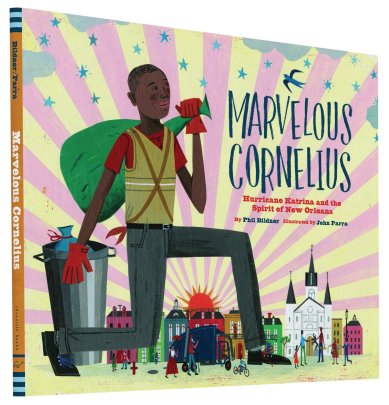
Marvelous Cornelius: Hurricane Katrina and the Spirit of New Orleans
Written by Phil Bildner
Illustrated by John Parra
Chronicle Books 8/04/2015
978-1-4521-2578-7
44 pages Age 3—5
“In New Orleans, there lived a man who saw the streets as his calling, and he swept them clean. He danced up one avenue and down another and everyone danced along—The old ladies whistled and whirled. The old men hooted and hollered. The barbers, bead twirlers, and beignet bakers bounded behind that one-man parade. But then came the rising Mississippi—and a storm bigger than anyone had seen before. Phil Bildner and John Parra tell the inspirational story of a humble man, and the heroic difference he made in the aftermath of Hurricane Katrina.” [inside jacket]
Review
Marvelous Cornelius, the person, embodies the best of us. Day-to-day he performed his job—one many would consider unglamorous—with dignity, enthusiasm, and a spirit of giving to those he served. People responded positively to this larger-than-life man. Kids enjoyed his spirited antics. When disaster struck in the name of Hurricane Katrina, this French Quarter-New Orléans resident went to work cleaning up his city with the same joyousness as before, only this time, the residents responded not only with enjoyment to see their local “hero,” but pitched in following his lead. Together—including many volunteers from outside of New Orléans—Marvelous Cornelius led his neighbors in cleaning up their beloved city. Just as he did on his daily job, Marvelous Cornelius helped keep New Orléans clean, for he was a garbage man by trade; garbage man extraordinaire.
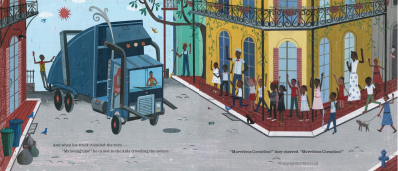 With the use of many writing techniques—alliteration, repetition, and exaggeration—author Bildner keeps the story lively. Children will enjoy Cornelius Washington’s story of how an ordinary citizen can help keep their city or town upbeat, their neighbors friendly and joyous, and their streets clean, making for a wonderful place to live.
With the use of many writing techniques—alliteration, repetition, and exaggeration—author Bildner keeps the story lively. Children will enjoy Cornelius Washington’s story of how an ordinary citizen can help keep their city or town upbeat, their neighbors friendly and joyous, and their streets clean, making for a wonderful place to live.
 At times, the illustrations portray Marvelous Cornelius as a literal giant emphasizing his larger-than-life persona. He becomes more realistic when portrayed with the residents he served. I would have liked to have seen a more multicultural representation of the residents of New Orléans, though artist Parra may have decided to show a true representation of the resident’s Cornelius Washington actually served. Of note: the illustrations do show a multicultural people once the city is swept clean of the “gumbo of mush and mud.”
At times, the illustrations portray Marvelous Cornelius as a literal giant emphasizing his larger-than-life persona. He becomes more realistic when portrayed with the residents he served. I would have liked to have seen a more multicultural representation of the residents of New Orléans, though artist Parra may have decided to show a true representation of the resident’s Cornelius Washington actually served. Of note: the illustrations do show a multicultural people once the city is swept clean of the “gumbo of mush and mud.”
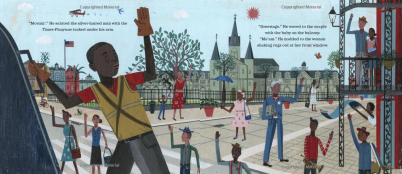 The art is a delight with its rustic feel and animations of Cornelius “Tango-ing up Toulouse” and “Samba-ing down St. Peter.” I loved the changing text size and font when Marvelous Cornelius sang out his familiar calls:
The art is a delight with its rustic feel and animations of Cornelius “Tango-ing up Toulouse” and “Samba-ing down St. Peter.” I loved the changing text size and font when Marvelous Cornelius sang out his familiar calls:
“WOO! WOO! WOOOOO! WOO! WOO! WOOOOO!”
“RAT-A-TAT-TAT RAT-A-TAT-TAT
“HOOTIE HOO! HOOTIE HOOOOO! SHOWTIME!”
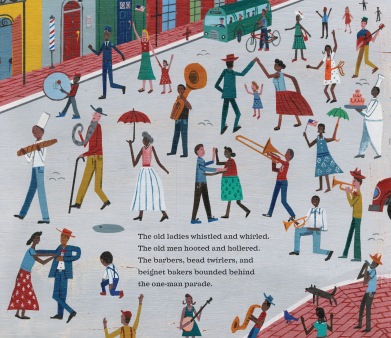
At story’s end, the author writes more about New Orléans, its people, and Hurricane Katrina (which brought major devastation to this coastal city). Bildner also delves into his writing style, saying his use of alliteration, repetition, and exaggeration helped him write Cornelius Washington’s story as a folktale, similar to that of John Henry. Together with artist Parra, Bildner has succeeded in writing a story every child should read and will most definitely enjoy. Teachers can find many lessons in Mr. Washington’s story of an average person who rose to heroic heights simply by doing his best every day.
MARVELOUS CORNELIUS: HURRICANE KATRINA AND THE SPIRIT OF NEW ORLEANS. Text copyright © 2015 by Phil Bildner. Illustrations copyright © 2015 by John Parra. Reproduced by permission of the publisher, Chronicle Books, San Francisco, CA.
Purchase Marvelous Cornelius: Hurricane Katrina and the Spirit of New Orleans at Amazon —Book Depository—iTunes Books—Chronicle Books.
—Book Depository—iTunes Books—Chronicle Books.
Learn more about Marvelous Cornelius: Hurricane Katrina and the Spirit of New Orleans HERE.
Find a Common Core-Aligned Teacher’s Guide HERE.
Read more about Katrina’s Children HERE.
Watch the full length video Katrina’s Children free HERE.
Meet the author, Phil Bildner, at his website: http://philbildner.com/
Meet the illustrator, John Parra, at his website: http://www.johnparraart.com/
Find more picture books at the Chronicle Books website: http://www.chroniclebooks.com/
Copyright © 2015 by Sue Morris/Kid Lit Reviews. All Rights Reserved
Full Disclosure: Marvelous Cornelius: Hurricane Katrina and the Spirit of New Orleans, by Phil Bildner & John Parra, and received from Chronicle Books, is in exchange NOT for a positive review, but for an HONEST review. The opinions expressed are my own and no one else’s. I am disclosing this in accordance with the Federal Trade Commission’s 16 CFR, Part 255: “Guides Concerning the Use of Endorsements and Testimonials in Advertising.”
Filed under:
5stars,
Children's Books,
Favorites,
Historical Fiction,
Library Donated Books,
Picture Book Tagged:
alliteration,
Chronicle Books,
community spirit,
Cornelius Washington,
exageration,
folklores,
Hurricane Katrina,
John Parra,
joy,
Katrina's Children,
Marvelous Cornelius: Hurricane Katrina and the Spirit of New Orleans,
Phil Bildner,
repetition,
writing technique 







By:
Sue Morris @ KidLitReviews,
on 7/5/2015
Blog:
Kid Lit Reviews
(
Login to Add to MyJacketFlap)
JacketFlap tags:
Children's Books,
Picture Book,
Dr. Seuss,
Favorites,
beginning readers,
rhyming picture book,
repetition,
phonetics,
5stars,
Library Donated Books,
HarperCollins Children’s Books,
Emma J. Virján,
Pig in a Wig,
swimming in a moat,
What This Story Needs Is a Pig in a Wig!,
Add a tag
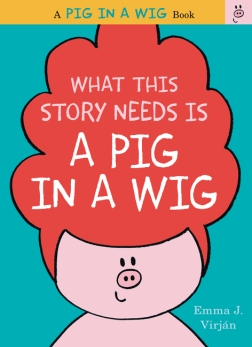 What This Story Needs Is a Pig in a Wig
What This Story Needs Is a Pig in a Wig 
Written & Illustrated by Emma J. Virján
HarperCollins Children’s Books
05/12/2015
978-0-06-232724-6
32 pages Age 1—3
“What this story needs is a pig in a wig on a boat with some friends having fun in the sun–So come on board! Join Pig on an exciting boat ride where she discovers that life is a lot more fun with more friends.”[back cover]
Review
NOTE: This review is a tad unusual. It mixes my traditional review format with interview questions asked of the pig in a wig.
What This Story Needs Is a Pig in a Wig will instantly remind you of dear ole Dr. Seuss. The author employs fast-paced writing combined with simple, but effective, rhymes young children will love to hear and repeat. The narrator sends Pig, wearing a stunning pink wig—what is with that wig—sailing the moat in a boat. Why would a pig wear a wig? Well, I asked Pig and she said (rather emphatically),
“Wigs are fun and I’m a pig that loves to have fun!”
If you venture to Pig’s website—and I do suggest you do—you will find Pig is not simply a pink wig gal.

Back to the story: One by one, the narrator adds a menagerie of interesting, kid-friendly animals to the boat in the moat. A frog, a dog, and a goat on a log join Pig in her wig. But there are more. A rat, wearing a cool hat, sits on a trunk—belonging to an elephant—with a skunk, who is with a mouse in a house. I was beginning to wonder what other animal could possibly be added to the small boat in the moat, when Pig yelled at the narrator. I asked Pig why she stopped all of the narrator’s fun. I thought it was very exciting having rhyming animals set sail. Pig had a different point of view:
“It was getting crowded, too crowded — a frog, a dog, a goat on a log,
a rat in a hat on a trunk, with a skunk, in a house, with a mouse AND
a panda in a blouse? It was more than my little, pink boat could handle.”
Pig is right, the small boat is crowded. So, beginning with the Panda—she performs a cannonball—the narrator reverses course, sending the animals out of the boat and into the moat. Once they leave, the narrator changes the story:
“What this story needs
is a pig in a wig,
on a boat,
in a moat,
having fun,
in the sun,
on her own . . .”
Now, all alone in her boat, Pig is sailing the moat. I think Pig is lonely and realizes she enjoyed her new animal friends. So the pig in a pink wig called for her new friends to return. Taking charge of the narration, Pig decides what the story needs . . .

Pig in a Wig, is a fun story young children will love to hear. The rhyming is simple, yet smart and witty. Kids will be reciting Pig in a Wig and, hopefully, figuring out their own rhyming group of friends. The illustrations are clean and engaging. Many pages hold surprises, such as a pig snout rug, Frog doing a hand-stand, and Dog and Goat holding hands. Dr. Seuss would love Pig in a Wig, which happens to be the same size as an iconic Dr. Seuss book. The simple story will charm young children during story time at school or a library. What This Story Needs Is a Pig in a Wig is so much fun to read I hope to see Pig in new stories.
I asked one last question, wondering, with all those charismatic animals on board, who is Pig’s favorite passenger. She said,
“Well . . . none were my favorite at the beginning, as they were all getting
in my way of having fun in the sun! At the end though, ALL of them were
my favorite, with Goat on his log being my extra, extra favorite.”
WHAT THIS STORY NEEDS IS A PIG IN A WIG. Text and illustrations copyright (C) 2015 by . Reproduced by permission of the publisher, HarperCollins Children’s Books, New York, NY.
Purchase What This Story Needs is a Pig in a Wig at Amazon —Book Depository—Apple iBooks—HarperCollins Children’s Books.
—Book Depository—Apple iBooks—HarperCollins Children’s Books.
Learn more about What This Story Needs is a Pig in a Wig HERE.
There are Coloring Sheet HERE,
An Activity Guide HERE,
And a Teacher’s Guide HERE.
Pig in a Wig’s website: http://emmavirjan.com/pig-in-a-wig/
Meet the author/illustrator, Emma J. Virján, at her website: http://www.emmavirjan.com
Find more engaging picture books a the HarperCollins Children’s Books website: http://www.harpercollins.com/
x
Copyright © 2015 by Sue Morris/Kid Lit Reviews. All Rights Reserved
Review section word count = 453
Full Disclosure: What This Story Needs is a Pig in a Wig, by Emma J. Virján, and received from HarperCollins Children’s Books, is in exchange NOT for a positive review, but for an HONEST review. The opinions expressed are my own and no one else’s. I am disclosing this in accordance with the Federal Trade Commission’s 16 CFR, Part 255: “Guides Concerning the Use of Endorsements and Testimonials in Advertising.”
Filed under:
5stars,
Children's Books,
Favorites,
Library Donated Books,
Picture Book Tagged:
beginning readers,
Dr. Seuss,
Emma J. Virján,
HarperCollins Children’s Books,
phonetics,
Pig in a Wig,
repetition,
rhyming picture book,
swimming in a moat,
What This Story Needs Is a Pig in a Wig! 








By: Carter Higgins,
on 8/26/2014
Blog:
Design of the Picture Book
(
Login to Add to MyJacketFlap)
JacketFlap tags:
design,
color,
adam rex,
balance,
pattern,
concept,
rhythm,
perspective,
color palette,
repetition,
zack rock,
creative editions,
Add a tag

by Zack Rock (Creative Editions, 2014)
Zack Rock and I haunt some of the same circles on the internet. I have a tshirt with his work on it thanks to Vintage Kids’ Books My Kid Loves (how cool is that header?), and I have long admired his work thanks to some tea time at Seven Impossible Things here and here. And once upon a time in 2012, Zack wrote a hilarious joke for a Hallowtweet contest run by Adam Rex and Steven Malk.
I remember that well, cause in fun-facts-here-at-Design-of-the-Picture-Book both Julie Falatko and I were runners-up in that contest, and the real prize was getting her friendship. Start of an era, for sure. (Although Zack did get an original piece of Adam Rex art, and we’d both admit to coveting that a little. See below!)
So. I’ve had my eye out for this book for years. Years! And I was so happy that Zack spent some time chatting with me about this smorgasbord of stuff and story. He also said he “answered the living daylights” out of these questions, so I sure hope you enjoy the living daylights out of them like I did.
Welcome, Zack! (That jovial picture is from his blog, where he has killer posts like this one on bad drawings and perspective. Check it out!)



One thing I know that’s true of kids is that they love a billion teensy and scrutinize-able details in books. Your book starts out with such cool stuff on the endpapers, that I almost (only almost) don’t want to keep going! Do you have any kind of catalog for these curiosities, or did you just create anything and everything that felt right? Is there a backstory for each of these elements?!
I drew whatever felt right, “right” being subject to how exhausted my imagination was at the time. And though I’d like to leave the history of the curios up to the readers’ interpretation, I carry a backstory for each in my mind—some more convoluted than others.
For instance, in the museum there’s an antique, penny arcade cabinet inspired by the Musée Mécanique, which houses scores of these old contraptions in San Francisco. So to honor them, I fitted my museum’s machine with a tiny, top-hatted automaton of one of SF’s most curious citizens: Norton I, self-proclaimed Emperor of the United States of America (a real guy). So plenty of thought went into that curio.
On the other hand, another curio is an apple with a faucet sticking out of it because I was thirsty when I drew it.
(I love the way this whole book starts. I feel like I’m in really good hands.)
Thanks! I like to consider myself the Allstate of illustrators.
What’s your studio like? Do you have trinkets and tschotskes or a cool window view?
Believe it or not, I’m allergic to collecting stuff, so my studio is bare as a monk’s cell. My mother, however, has a fondness/compulsion for antiquing in bulk; almost none of her massive collection of furniture and doodads got past the door of my childhood home without having first seen several generations of use. It lent the crowded house an air of the same well-worn nostalgia that permeates the pages of my book.
Surely you’ve hidden some easter eggs in these pages. Any hints? Any behind-the-scenes stories?
Now I regret not hiding an actual Easter Egg in the museum. Honestly, nearly everything in the book is an Easter Egg, since there’s a secret story encased in each curio. But instead of cracking those open, I’ll share a behind-the-scenes tour of the book’s present day setting.
I created the book while living in Seattle, and Pacific Northwest references are littered throughout it. The license plate on the VW Bug in the first scene reads “FRMTTRL,” an allusion to the massive concrete Fremont Troll lurking beneath the Seattle’s Aurora Bridge. The museum exterior is based on the old town hall in Bellingham, WA, and the fictional island it crashed on is named for Washington State’s notorious children’s writer, Sherman Alexie. A Washington State ferry, the Olympic Mountains, a totem pole from Pike Place Market, and a handful of other Puget Sound souvenirs also make an appearance in the book.
This book has a real undercurrent of ignored things being a treasure with a story. Are you a treasure hunter or a treasure-leaver-for-somebody-else? (I think that’s what making books is, so you are that one for sure. I guess what I’m asking is why do you think HHH was such a collector of stories, and do you see any parallels in your own life of creative curating?)
Ooo, books as treasures to be discovered, I like that! Makes me sound like a pirate.
Homer is an underdog; nobody would look at him and assume his adventures extend beyond an expedition to the local sushi restaurant. He identifies himself with the object’s he curates, so he surrounds himself with the lost and neglected, and by exhibiting their rich history to the world he literally shares his own biography.
And I’ll leave the parallels with my own life to the armchair psychoanalysts.
What came first to you in this story: words or pictures? Can you talk to being a picture book creator who deals with both parts? (And in case anyone’s wondering, my favorite line is this one: My luggage may be dusty. But my hat still fits.)
Ha, that’s the one line written entirely by my editor Aaron! He suggested it while editing the book, and I thought it was great too, so we kept it in.
Being an author/illustrator isn’t terribly different than being solely a writer, the main distinction is that you have a visual language to express the story as well. So I can employ the duel butterfly nets of text and images to capture the picture book ideas that flutter into view, jotting notes alongside small thumbnail sketches as I try to pin down plot/character/theme details. It becomes a balancing act of seeing which of the two, words or images, best conveys what needs to be communicated.
 What’s your creative process like? Any weird routines? What’s your medium of choice?
What’s your creative process like? Any weird routines? What’s your medium of choice?
My only real habit—creative or otherwise—are the nightly walks I take after work, allowing my legs and mind to wander. In fact, I got the original idea for Homer Henry Hudson during one of these constitutionals.
And for picture books I work almost exclusively in watercolor, though for other projects I work in pen and ink, digitally, or with accidental food stains.
Who are your literary and artistic heroes?
They’re all in the book! Along with Shaun Tan, Maurice Sendak and Lisbeth Zwerger—who I painted into a restaurant scene—there’s references to Søren Kierkegaard, Jorges Luis Borges, Franz Kafka, Renee Magritte, Herman Melville, JD Salinger, George Orwell, Ingmar Bergman, Charles Schulz, and of course, Homer. Even my favorite comedian, Paul F Tompkins, whose podcasts kept me company during the long hours of illustrating the book, has a cameo as a pipe-smoking painting.
Do you have a favorite piece of artwork hanging in your house? Or a favorite tune that feels like art?
A few years ago, Adam Rex held a contest to see who could fit the best Halloween haiku into the constraints of a tweet. To my surprise he picked mine, and to my utter flabbergastination he went on to illustrate it and sent me the original art! It’s incredible. I framed it above my art desk as a reminder that, with hard work and dedication to my craft, I may one day hope to be the poor man’s Adam Rex.
Why books for kids?
One of the most valuable skills to possess is the ability to approach the world and its inhabitants with wonder, curiosity and interest. What’s great about kids is that they do this naturally and without being self-conscious. My hope is that Homer Henry Hudson’s Curio Museum and future books will be something readers carry with them as they grow older and are tempted to lose that wonder, reminders there’s so much more to the world, the things in it, and yourself to discover if you approach life with an open heart.
Plus, I have nothing to say that couldn’t be said by a talking dog. What’s next for you?
What’s next for you?
Another book for Creative Editions about the power of stories, this time from the perspective of an acrobatic pig.
How can we buy your book?
Through your local struggling independent bookseller. Or Powells.com. Or, sigh, Amazon.com.
What did I miss?
There are humanoid pears hanging in the first illustration of the museum interior, bottom of the page. Look past the table leg and Grecian urn. See that? It’s a butt!
 I’m pretty sure that’s the first butt mention on this blog. Have any treasure-hunters? Or fans of hidden picture art? Since we all love talking dogs, this book is a great choice for all readers everywhere.
I’m pretty sure that’s the first butt mention on this blog. Have any treasure-hunters? Or fans of hidden picture art? Since we all love talking dogs, this book is a great choice for all readers everywhere.

Tagged:
adam rex,
color,
creative editions,
pattern,
repetition,
zack rock 
.png.jpg?picon=4257)
By: Diana Hurwitz,
on 8/15/2014
Blog:
Game On! Creating Character Conflict
(
Login to Add to MyJacketFlap)
JacketFlap tags:
fiction,
editing,
writing,
language,
revision,
craft,
vocabulary,
proofreading,
redundancy,
repetition,
word use,
Add a tag
Redundant words are so common they are hard to recognize. Redundancies use two words when one will do. They are found in newspapers, broadcasts, and magazine articles.
A character would use redundancies in conversation. Few speak that formally.
Search for them all. Choose which ones to keep and which to kill.
Cutting some of them feels like amputating a limb.
Yes, this rule is frequently broken . You will find redundancies everywhere. You decide.
Here is a short list to get you started:- absolutely essential
- absolutely perfect
- absolutely positive
- actual fact
- advance forward
- advance planning
- advance preview
- advance reservations
- advance warning
- add an additional
- add up
- added bonus
- affirmative yes
- aid and abet
- all-time record
- alternative choice
- A.M. in the morning
- and etc.
- anonymous stranger
- annual anniversary
- armed gunman
- artificial prosthesis
- ascend up
- ask the question
- assemble together
- attach together
- ATM machine
- autobiography of his/her own life
REVISION TIPS
? Do a search using [Control] [F] for redundant words. Eliminate one of the redundant words.
? If you keep a redundancy, use it sparingly and for effect.
? If you disagree with this rule, ignore it. Make sure your editor and agent feel the same way.
For a larger list of some common redundancies and other revision layers, pick up a copy of:

By: Carter Higgins,
on 3/31/2014
Blog:
Design of the Picture Book
(
Login to Add to MyJacketFlap)
JacketFlap tags:
balance,
pattern,
rhythm,
black and white,
value,
texture,
composition,
line,
repetition,
perception,
contrast,
who needs donuts?,
mark allen stamaty,
design,
color,
Add a tag
 By Mark Alan Stamaty
By Mark Alan Stamaty
Published 1973 by Dial Press, reprinted 2003 by Alfred A. Knopf, an imprint of Random House Children’s Books.
At first glance, the answer to this book’s title is pretty clear. Because, everybody. But do you know this book? When I mention it to someone, I either hear about their favorite jelly donut (the one with strawberry), or they lose their sprinkles over the magnificence of this screwy tale.
But do you know this book? When I mention it to someone, I either hear about their favorite jelly donut (the one with strawberry), or they lose their sprinkles over the magnificence of this screwy tale.
The simplicity of the setup:
Sam lived with his family in a nice house.
He had a big yard and lots of friends.
But he wanted donuts, not just a few but hundreds and thousands and millions — more donuts than his mother and father could ever buy him.
Finally one day he hopped on his tricycle and rode away to a big city to look for donuts.
The scattered spectacle of the scene, a commotion in black and white. On those initial pages alone:
A bird in swim trunks
A roof-mowing man
A chimney blowing ribbons
A man in the window reading a newspaper with the headline, Person Opens Picture Book Tries to Read the Fineprint
Two donuts
And a cinematic, get-ready-for-your-close-up page turn. (Be sure to look closely in the blades of grass.) There’s almost a calm in the chaos. It’s regular and rhythmic and pandemonium and patterned all at once. Perfect for a story that’s a little bit bonkers and a whole lot of comfort.
There’s almost a calm in the chaos. It’s regular and rhythmic and pandemonium and patterned all at once. Perfect for a story that’s a little bit bonkers and a whole lot of comfort.
So. Then what? The relative calm of Sam’s neighborhood yields to an even madder and mayhem-ier sight.
The relative calm of Sam’s neighborhood yields to an even madder and mayhem-ier sight.

 Then Mr. Bikferd and his wagon of donuts shows up.
Then Mr. Bikferd and his wagon of donuts shows up.
And a Sad Old Woman. And Pretzel Annie.
Sam continues to collect donuts. Stocks and piles of donuts.
 A wagon breaks. A repairman helps. A love story. Abandonment.
A wagon breaks. A repairman helps. A love story. Abandonment.
(A fried orange vendor. A bathing zebra. Rollerskates. A Sad Old Woman.)
Who needs donuts when you’ve got love? When Sam rides home, the words that began his story are on the sidewalk. I get the shivers about that.
When Sam rides home, the words that began his story are on the sidewalk. I get the shivers about that.
The starts of stories are carved in concrete.

P.S. – These pictures remind me a little of what I’m seeing for Steve Light’s new book, Have You Seen My Dragon? Check out this review where Betsy Bird notices the same, and this post at Seven Impossible Things Before Breakfast, because it’s always a treat. I also think of the hours I’d spend as a kid studying each square centimeter of The Ultimate Alphabet. Like Waldo, but weirder.
Tagged:
black and white,
color,
line,
mark allen stamaty,
pattern,
repetition,
rhythm,
texture,
who needs donuts? 
You write a book, you begin to market it to agents or publishers, and then, zero. Nada. Zilch. In other words, the story you poured your heart and soul into sits in the document file of your computer or is shoved to the back of a filing cabinet.
If you find this happening to a piece of your writing, take another look at what you've put on paper. More than likely, the story has a flaw that can be fixed, and in the long run, these edits will make it a stronger piece of writing.
- No action, no reaction. Without a catalyst for action, a story sits - and will more than likely never sell. It's a basic notion of physics, and in this case, literature: Something must happen that causes a reaction from characters. Now, the action doesn't have to be major, but a single event or non-event acts as a turning point for a story.
- Whoa, Nellie! Have you ever started reading (or writing) a story that has too much exposition and by the time you reach what should be the beginning, you've lost interest? I find this a lot when I edit stories for a publishing company, and it always reminds me of lines from The Best Christmas Pageant Ever. "Begin at the beginning." "The beginning?" asked my mother. "The beginning of the story." Readers don't want to get bogged down with information that does not impact the storyline.
- Repetition. I'll plead guilty to this common flaw. I find I overuse certain words or phrases. They are everywhere! A few weeks ago, I was reviewing several poems I have written to submit to a contest. That's when it struck me: I have a pet phrase that showed up in all five poems. It's the same principle when you write fiction or non-fiction: tell us what you want to tell us. Readers don't need to be constantly reminded of something that happened.
If you have a manuscript stuck in a drawer, give it a second perusal and see if you can apply any of these fixes.
Have you committed any of these story flaws?
by LuAnn Schindler
The Redundant, Revenant Recidivist
"Despite its tireless narrative energy, despite its relentless inventiveness, the book is bloated, grown to elephantine proportions... Repetition is the problem; the same stories are told several times, accruing more dealt in with each telling. Also, the principal characters have a way of regurgitating what they've learned, even through the reader was with them when they learned it."
Patrick McGrath, in a New York Times review of The Witching Hour, by Anne Rice.
The problem Mr. McGrath describes is one we see regularly in the writing of both novices and professionals; unintentional repetition.
The repetition of an effect can be just as problematic. Whether it's two sentences that convey the same information, two paragraphs that establish the same personality trait, or two characters who fill the same role in a plot, repetition can rob your story of its power. In fact, repetition is likely to weaken rather then intensify the power of that effect.
When you try to accomplish the same effect twice, the weaker attempt is likely to undermine the power of the stronger one.
One form of repetition that we've seen more often in recent years is the use of brand names to help characterization. The mention of what type of scotch hour hero drinks or what kind of car your heroine drives may help give your readers a handle on their personalities. But when all your characters glance at their Rolexes, then hop into their Maseratis to tear out to the house in the Hamptons, where they change out of their Armanis to pour themselves a Glenliovet-you've gone too far.
Interior monologue is also prone to needless repetition.
Keep an eye out for unconscious repetitions on the smallest scale-especially repetitions in which the repeated word isn't used in the same sense as the original word. ("She heard a sharp crack, the loud spring of her bed springs.")
A fringe benefit of getting rid of unnecessary repetitions is that it frees up the power of intentional repetitions.
As you come to see what each element of your story-each sentence, each paragraph-accomplishes, you can learn o accomplish more than one thing at a time.
If each element of your story accomplishes one thing and one thing only, then your story will subtly, almost subliminally, feel artificial. When everything seems to be happening all at once, then it will feel like real life.
Another way in which the writers indulge in the large scale overkill is in the creation of the characters.
Then there is repetition on the largest scale, from book to book...of course, there is room in the world of fiction for the formulaic novel, it's been said that every James Bond novel has the same plot. (Oh, don't get me started. IF any of you EVER think that I am writing the same plot, over and over again, by simply changing the character names and the location, then, please, do not shoot me in the ass. Aim higher and put an end to my drivel.) (I refuse to read formulaic novels.)
~~~~~~~~~~
Thanks for following (Get the hint?). I hope this is helpful to someone out there. It has certainly improved my writing. Please comment and share the blog. Who knows, it may make the difference to someone.
.jpeg?picon=893)
By: LuAnn Schindler,
on 2/20/2011
Blog:
WOW! Women on Writing Blog (The Muffin)
(
Login to Add to MyJacketFlap)
JacketFlap tags:
listening,
dialogue,
LuAnn Schindler,
realistic dialogue,
creating characters,
repetition,
tips for writers,
fictional characters,
repeated phrases,
precision in writing,
Add a tag

Whoa, that convo would never take place!
Ever read a novel and have that thought come to mind while perusing the dialogue? That situation happened to me this week. Twice, in fact. One incident involved a YA novel. As an educator, I hear enough teen talk to know what's real and what's phony as a $3 bill. The other time I was critiquing a short story. Everything flowed in the piece, except the dialogue. Nothing like stealing that "feel good" feeling from a great piece of literature. (Insert frown here.)
Writers need to keep dialogue real; otherwise, readers will tune out. What are the best ways to pump up the reality volume of what your characters are saying? These tips will help you fine tune your characters' messages:
- Listen and Learn Unless you isolate yourself from the outside world, conversations that you can learn from take place all the time. Call if eavesdropping, but if you just sit and listen to people talk, you'll learn to pick up speech patterns, key words, phrasing, and rhythm - all which will help you write a realistic scene. For example, I attended a comedy show last night and paid attention to the comedian riff with an audience member. The comedian used timing to his advantage, creating this natural conversation with the guy in the front row. As the dialogue continued, even the audience member seemed to pick up on the established rhythm the comedian employed. It was a perfect example of listening and learning how individuals talk and respond to each other. One of the best methods for improving dialogue technique may require popcorn. Watch a movie and discover how each character treats the dialogue. It's more than words. Dialogue also means you're creating a mood, setting up a reaction, and propelling a character into new situations.
- Precision Trumps Surplus Once you've mastered listening, put your skills to the test. Dialogue shouldn't provide full disclosure. Instead, writers need to discern which information should be offered through dialogue. Info overload makes dialogue sound stilted. What's the best advice? Precision. Precision. Precision. A character's dialogue should make a point. Otherwise, it sounds fake.
- The Rule of Three Repetition can be a writer's best tool to drive home a point. When writing stand up comedy, you give two examples and then bam! hit the audience with a twist the third time. It's the same "rule of three" idea with fiction. Writers employ a key word or phrase three times in a row to emphasize a point. Moderation is the key with the rule of three. Too much of a good thing makes dialogue sound phony.
- Speak Up Once you've completed a scene, read it aloud. Do the words match the intended tone and message? Or does the conversation sound bogus? Sometimes I'll record a scene as a .wav or MP3 file, play it back, and hear where changes are needed. If you're part of a critique group, read snippets of dialogue to group members and use their input to decide whether or not the words flow or if the conversation needs to be rewritten.
Perhaps Alfred Hitchcock summed up realistic dialogue when he said, "Dialogue should simply be a sound among other sounds, just something that comes out of the mouths of people whose eyes tell the story in visual term
Sweet Moon Baby: An Adoption Tale, which is written by Karen Henry Clark and illustrated by Patrice Barton, was released last month. When I received my review copy, from Knopf Delacorte Dell Young Readers Group, I began reading it and felt tears well-up in my eyes. The lump in my throat stayed throughout the entire [...]

By:
Darcy Pattison,
on 11/17/2010
Blog:
Darcy Pattison's Revision Notes
(
Login to Add to MyJacketFlap)
JacketFlap tags:
Roz Morris,
sense of purpose.,
conflict,
book,
novel,
change,
scene,
revise,
edit,
how to,
repetition,
consequences,
novel revision,
Add a tag
Top 5 Tips for Dynamite Scenes
Guest Post By Roz Morris

 Join us on Facebook for a discussion of scenes.
Join us on Facebook for a discussion of scenes.
Have you got a scene that’s looking lifeless? Here’s how I pep it up.
Have something change.
No scene should ever go as the reader expects. If you have a character set out to buy a pint of milk and all they do is amble to the shop, buy their stuff and walk back, you’ve hit the snooze button. Instead, take that scene somewhere the reader is not expecting. It needn’t be a big twist. It could be tiny – a change of mood, a resolution to do something. But if nothing changes, the scene isn’t worth showing.
To keep the sense of progress through the story, a scene should always contain change. Otherwise it hasn’t earned its place in the story.
Make that change have consequences for the characters.
Suppose you add something to your milk-buying scene – the character realises her boyfriend claimed he bought a certain brand of cigarette from the corner shop, but that shop doesn’t sell them. So where did he get them? And isn’t it odd that they are the same brand smoked by his ex? Are they seeing each other again?
If a change has happened, it should have a lasting effect in the story. Again, it could be small, or it could set them on a new and dastardly path. Good scenes don’t exist in isolation; they affect what comes after them. And they are affected by what happened before.
If you have to fill a blank, bring something in that you introduced earlier.
In the thick of a scene, you often have to invent details off the top of your head. Where was your minor character John last night? The cinema, you write, because it doesn’t matter where he was, he’s not very important. But go back and look at what you’ve written about John before. Is there something else you already invented that you could bring in instead? Three chapters ago, did you send him, quite casually, to choir practice? Why not send him there again, or to the chemist to get throat lozenges? Now we’re fleshing John out and with very little effort.

Bringing back ideas you used before is a great way to make the world of your story feel more solid.
Even if what you’re using is trivial it can build up – and who knows where it might lead? It’s a technique called reincorporation. It makes stories elegant and satisfying. And it adds to the feeling that everything matters.
Keep a list of everything you plucked off the top of your head because you needed to fill a blank space. You’d be surprised how useful it will be.
Always
Written by Ann Stott
Illustrated by Matt Phelan
Published by Candlewick Press in August 2008
Review copy provided by the publisher
Always is a touching tale about a young boy who questions whether his mother’s love (for him) is unconditional. He asks his mother a series of questions that include whether she loves him he remembers to feed [...]









































My first and only attempt at a novel had, I think, every one of these stinkin' flaws! I tucked it away for now and am pursuing other writing I find more fulfilling and chalked it up to a fun learning experience. These are good flags to be aware of.
LuAnn--I'm working on a novel and I am afraid it's full of some of the flaws you're warning about, along with some "new" ones. Yikes!
Thanks for the flares you've set off. I'll be sure to keep an eye out for them as I proceed down this curvy path...
I always apply the action-reaction premise to acting when I direct a play; students don't always realize there needs to be a reaction to every line, whether it's a physical change in stance or a changed facial expression. I hope that has carried over to my writing. Now I need to work on the other two...
I'll be giving a few more fixes then next time I blog. :)